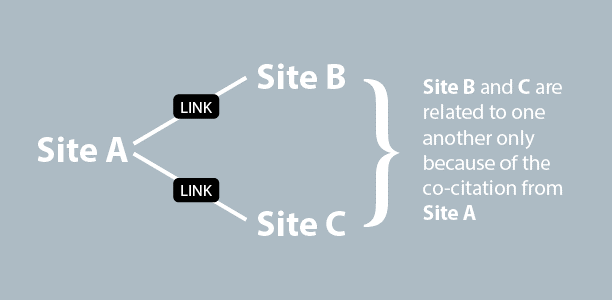As we all work to understand Google’s algorithm and become proactive and not reactive in our marketing strategies, you have to be careful you’re not falling victim to just another buzzword (and in this industry, that can be hard to navigate).
We did the research for you to understand what co-citation and co-occurrence mean, how they’re different, and whether these are tactics to take seriously when it comes to strategizing the SEO of your website.
Hint, the answer might not be what you think!
What Is Co-Citation?
We all know that link building works; but this is much to Google’s dismay.
Enter co-citation (and co-occurrence for that matter, but we’ll get to in the next section).
Co-citation means that a website is mentioned by two different sources, but not necessarily linked. It’s really as simple as that.

For example, if Search Engine Journal is mentioned across many websites, even if it isn’t linked, Google will take note of this and call it co-citation.
This is a good thing.
The idea here is that this could happen indirectly or by accident, making all mentions feel really and truly honest.
Suddenly the site mentioned, along with all the sites that mention that site, are all related, and again, this is a good thing.
This podcast said it best when they say “that’s one of the reasons it may not necessarily be bad to see your site AND your competitors site linked to in the same article. It helps to put you on the same level via co-citation.”
What Is Co-Occurrence?
Once again, the idea here is that you want to rank for more than just keywords, but rather focus on ranking for concepts and ideas.
In order for the Google bots to crawl a piece of content and be able to pick out co-occurrence, they look for “close proximity of similar keywords present across several websites, which may include keywords that are similar to each other and based on the same topic, but not exactly the same” according to an SEO Hacker study.

Now, when we say keywords, this does not necessarily mean keyword links.
It’s all about utilizing key phrases within your content.
Seems easy enough, right?
So how do you determine which key phrases to link together in your content?
That comes down to search queries.
Think of this like keyword research, except instead of looking at how often a keyword is searched on Google, you’re looking at how different key phrases are searched together and consecutively.
Take the following two examples.
Example 1
Let’s say someone searches for the phrase “vacations to Costa Rica for families” and then looks up the phrase “Costa Rica group tours for families”.
If this happens enough, Google will begin associating the two terms together, and therefore assuming that group tours are what people look for when they search for Costa Rica family vacations.
In this situation, co-occurrence has occurred. As a writer or SEO, these are the terms you will want to associate together as well in your writing.
Example 2
If you search for “blackhawks” after searching for other types of common birds found in the Americas, or searching for bird watching vacations, Google will assume that you want to see more information on the black-hawk bird and not the Chicago hockey team (even despite spelling the bird slightly wrong).
Again, co-occurrence has occurred.
How to Get on Track with Co-Occurrence & Co-Citation
Your first step to success with co-occurrence and co-citation is to change your way of thinking and talk with your content writers.
Make sure they understand these concepts so that when writing they can incorporate authoritative mentions and related key phrases.
A few tips from this article on Uberflip:
- Continue to do your keyword research, but go one step further. Take each keyword you plan to use and then create a list of modifiers and try to incorporate those modifiers into your content.
- Try using similar words in your h1 and h2 tags, titles, and descriptions.
- Use a tool to help get creative and generate new ideas, such as Ahrefs Keyword Explorer.
- Again, talk to your writers. Your writers are going to be the ones who need to react to this way of thinking, so arm them with this knowledge and give them training.
Why Co-Occurrence & Co-Citation Make Sense
If you think about it, both co-citation and co-occurrence make complete sense when it comes to what Google has been trying to value all along – authority and real, genuine intermingling between great pieces of content.
If we follow the history of Google algorithm updates, we see that once again, this has been in the works for a while:
- Hummingbird Update: This rolled out in 2013 to help ensure that “pages matching the meaning do better, rather than pages matching just a few words.” Some would argue this was the start of this type of strategy.
- RankBrain: Launched in 2015, this is a machine-learning system that’s specific job is to look for similarities between pages that users find valuable.
- BERT: This update from October 2019, what Google called the “most important update in five years,” focused on being able to understand the context of words in your query. It put focus on natural language and conversational queries.
Why Link Building Still Makes More Sense
While the concept of co-citation and co-occurrence makes sense and does seem to have some legs in terms of where Google would ultimately like to go (not leaning on links as heavily), you would be wise not to go all-in on this.
I often try to explain that as much as people talk about links not being a necessity and that content is everything,
Google SERPs don’t back that up.
Focus on real-world examples.
Links are still vital to the success of a website and its ability to rank and I don’t see that changing anytime soon.
More Resources:
- TF-IDF: Can It Really Help Your SEO?
- Content Analysis and Better Ranking
- How to Execute a Link Conversion Strategy
Image Credits
Featured Image: Depositphotos.com
Other images taken from SEJ Article from March 2013




